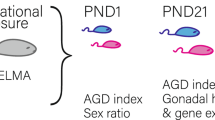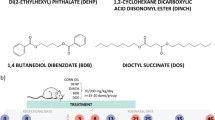Abstract
With the limited but ongoing usage of di-n-butyl phthalate (DBP) as plasticizer, the health effects of both phthalate and its alternatives are far from being understood. Multigenerational effects of phthalates were evaluated in rats upon exposure to DBP, aiming to provide some evidences about its potential in causing developmental teratogenicity. Gestational rats were exposed to DBP (500 mg/kg bw/day) and control groups with olive oil. On the 18th day of gestation, fetuses (F1) isolated from a few dams were subjected to prenatal screening, and the other rats were allowed to litter, and later postnatal screening was made. DBP-toxicated (F1) rats were crossed and reared up to three generations (F2 and F3) by adopting the same experimental design. A considerable decrease in the weight of placenta, low number of corpora lutea and increased resorptions, and pre- and postimplantation loss were observed in F1, F2, and F3 generations. Further, there was a decrease in the number of live births and fetal body weight with high mortality, the developmental indices showed reduction in litter size and sex ratio, and a considerable incidence of skeletal and malformation complex involving face and eye was observed in later generations compared to the first. The pre-weaning indices in neonates showed a considerable delay in physical growth milestones and poor scores in sensory motor development. Alterations noticed in the levels of thyroid profile and testosterone found to have a role in sensory motor, craniofacial development, and eye formation. In brief, results confirm multigenerational and fetotoxic effects of DBP; thereby, findings imply that developing tissues are the targets and endocrine disruption appears to be the underlying mechanism of phthalate action.






Similar content being viewed by others
References
Altman J, Sudarshan K (1975) Postnatal development of locomotion in the laboratory rat. Anim Behav 23(4):896–920
Bae J, Kim S, Kannan K, Louis GMB (2015) Couples’ urinary bisphenol A and phthalate metabolite concentrations and the secondary sex ratio. Environ Res 137:450–457
Bailey J, Knight A, Balcombe J (2005) The future of teratology research is in vitro. Biog Amines 19(2):97–145
Ema M, Amano H, Itami T, Kawasaki H (1993) Teratogenic evaluation of di-n-butyl phthalate in rats. Toxicol Lett 69(2):197–203
Ema M, Amano H, Ogawa Y (1994) Characterization of the developmental toxicity of di-n-butyl phthalate in rats. Toxicol 86(3):163–174
Ema M, Miyawaki E, Kawashima K (2000) Effects of dibutyl phthalate on reproductive function in pregnant and pseudopregnant rats. Reprod Toxicol 14(1):13–19
Gilbert-Barness E (2010) Teratogenic causes of malformations. Ann of Clin lab Sci 40(2):99–114
Foster PMD (2006) Disruption of reproductive development in male rat offspring following in utero exposure to phthalate esters. Int J Androl 29:140–147
Franciszek B, Szumiło J, Dudka J et al (2005) Morphological studies in modern teratological investigations. Folia Morphol (Warsz) 64(1):1–8
Gray LE Jr, Laskey J, Ostby J (2006) Chronic di-n-butyl phthalate exposure in rats reduces fertility and alters ovarian function during pregnancy in female Long Evans hooded rats. Toxicol Sci 93(1):189–195
James WH (2008) Evidence that mammalian sex ratios at birth are partially controlled by parental hormone levels around the time of conception. J Endocrinol 198:3–15
Jobling MS, Hutchison GR, van den Driesche S, Sharpe RM (2011) Effects of di(n-butyl) phthalate exposure on fetal rat germ cell number and differentiation: identification of age-specific windows of vulnerability. Int J Androl 34:e386–e396
Koch HM, Calafat AM (2009) Human body burdens of chemicals used in plastic manufacture. Phil Trans R Soc B 364(1526):2063–2078
Latini G, De Felice C, Presta G et al (2003) In utero exposure to di-(2-ethylhexyl)phthalate and duration of human pregnancy. Environ Health Perspect 111(14):1783–1785
Liu C, Zhao L, Wei L, Li L (2015) DEHP reduces thyroid hormones via interacting with hormone synthesis-related proteins, deiodinases, transthyretin, receptors, and hepatic enzymes in rats. Environ Sci Pollut Res 22:12711–12719
Li Y, Zhuang M, Li T, Nian S (2009) Neurobehavioral toxicity study of dibutyl phthalate on rats following in utero and lactational exposure. J App Toxicol 29:603–611
Meikle AW (2004) The interrelationships between thyroid dysfunction and hypogonadism in men and boys. Thyroid 14(Supplement 1):S17–S25
Mylchreest E, Cattley RC, Foster PM (1998) Male reproductive tract malformations in rats following gestational and lactational exposure to di(nbutyl) phthalate: an antiandrogenic mechanism? Toxicol Sci 43:47–60
O’Connor JC, Frame SR, Ladics GS (2002) Evaluation of a 15-day screening assay using intact male rats for identifying antiandrogens. Toxicol Sci 69(1):92–108
Pantaleoni G, Fanini D, Mariasponta A et al (1988) Effects of maternal exposure to polychlorobiphenyls (PCBs) on Fl generation behavior in the rat. Fundam Appl Toxicol 11:440–449
Parks LG, Ostby JS, Lambright CR et al (2000) The plasticizer diethylhexyl phthalate induces malformations by decreasing fetal testosterone synthesis during sexual differentiation in the male rat. Toxicol Sci 58:339–349
Ragge NK, Subak-Sharpe ID, Collin JRO (2007) A practical guide to the management of anophthalmia and microphthalmia. Eye 21:1290–1300
Richardson SJ, Wijayagunaratne RC, D’Souza DG et al (2015) Transport of thyroid hormones via the choroid plexus into the brain: the roles of transthyretin and thyroid hormone transmembrane. Front Neurosci 9:1–8
Saillenfait AM, Langonne I, Leheup B (2001) Effects of mono-n-butyl phthalate on the development of rat embryos: in vivo and in vitro observations. Pharmacol Toxicol 89:104–112
Saillenfait AM, Gallissot F, Sabaté J-P (2009) Differential developmental toxicities of di-n-hexyl phthalate and dicyclohexyl phthalate administered orally to rats. J Appl Toxicol 29:510–521
Salazar V, Castillo C, Ariznavarreta C et al (2004) Effect of oral intake of dibutyl phthalate on reproductive parameters of Long Evans rats and pre-pubertal development of their offspring. Toxicology 205(1–2):131–137
Masaru S, Wakui S, Wempe MF et al (2013) Male Sprague-Dawley rats exposed to in utero di(n-butyl) phthalate: dose dependent and age-related morphological changes in leydig cell smooth endoplasmic reticulum. Toxicol Pathol 41:984–991
Singh AR, Lawrence WH, Autian J (1972) Teratogenicity of phthalate esters in rats. J Pharm Sci 61(1):51–55
Tanaka T (2002) Reproductive and neurobehavioural toxicity study of bis(2-ethylhexyl) phthalate (DEHP) administered to mice in the diet. Food Chem Toxicol 40:1499–1506
Tanimura T, Ema M, Kihara T (1980) Effects of combined treatment with methylmercury and polychlorinated biphenyls (PCBs) on the development of mouse offspring. In: Persaud TVN (ed) Advances in the study of birth defects: neural and behavioral teratology, vol 4. University Park Press, Baltimore, pp. 163–198
Wo’jtowicz Anna K, Konrad AS, Agnieszka WnukMałgorzata Kajta (2016) Dibutyl phthalate (DBP)-induced apoptosis and neurotoxicity are mediated via the aryl hydrocarbon receptor (AhR) but not by estrogen receptor alpha (ERa), estrogen receptor beta (ERb), or peroxisome proliferator-activated receptor gamma (PPARc) in mouse cortical neurons. Neurotox Res 1–13 doi:10.1007/s12640-016-9665-x
Harold ZI (2013) Exposure to lipophilic chemicals as a cause of neurological impairments, neurodevelopmental disorders and neurodegenerative diseases. Interdiscip Toxicol 6(3):103–110
Zhang Y, Jiang X, Chen B (2004) Reproductive and developmental toxicity in F1 Sprague-Dawley male rats exposed to di-n-butyl phthalate in utero and during lactation and determination of its NOAEL. Reprod Toxicol 18(5):669–676
Ziejewski MK, Solomon HM, Rendemonti J, Stanislaus D (2015) Comparison of a modified mid-coronal sectioning technique and Wilson’s technique when conducting eye and brain examinations in rabbit teratology studies. Birth Defects Res B 104:23–34
Zoeller RT, Rovet J (2004) Timing of thyroid hormone action in the developing brain: clinical observations and experimental findings. J Neuroendocrinol 16:809–818
Author information
Authors and Affiliations
Corresponding author
Additional information
Responsible editor: Philippe Garrigues
Rights and permissions
About this article
Cite this article
Mahaboob Basha, P., Radha, M.J. Gestational di-n-butyl phthalate exposure induced developmental and teratogenic anomalies in rats: a multigenerational assessment. Environ Sci Pollut Res 24, 4537–4551 (2017). https://doi.org/10.1007/s11356-016-8196-6
Received:
Accepted:
Published:
Issue Date:
DOI: https://doi.org/10.1007/s11356-016-8196-6




